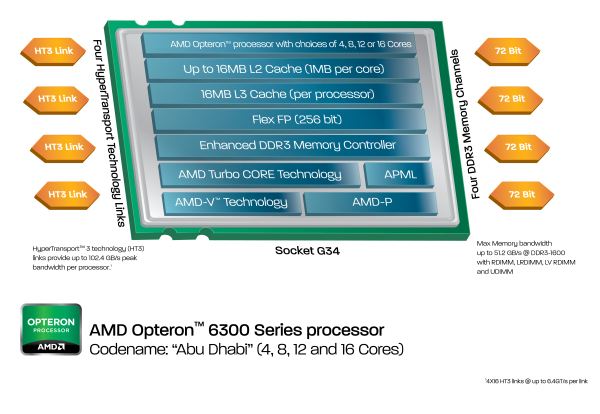The new Opteron 6300: Finally Tested!
by Johan De Gelas on February 20, 2013 12:03 AM ESTAMD unveiled their Opteron 6300 series server processors, code name Abu Dhabi, back in November 2012. At that time, no review samples were available. The numbers that AMD presented were somewhat confusing, as the best numbers were produced running the hard to assess SPECJbb2005 benchmark; the SPEC CPU2006 benchmarks were rather underwhelming.
Compared to an Opteron 6278 at 2.4GHz, the Opteron 6380 (2.5GHz) performed 24% better, performance per Watt improved by 40% according to AMD. In contrast, SPECint_Rate2006 improved by only 8%, and SPECfp_Rate2006 by 7%. However, it is important to note that SPECCPU2006 rates do not scale well with clockspeed. For example an 8% clockspeed (6380 vs 6376) only results in a 3.5% higher SPECint_Rate2006 and a 3% higher SPECfp_Rate2006. And the SPEC CPU 2006 benchmarks were showing the Interlagos Opteron at its best anyway. You can read our analysis here.
Both benchmarks have only a distant link to real server workloads, and we could conclude only two things. Firstly, performance per GHz has improved and power consumption has gone down. Secondly, we are only sure that this is the case with well optimized, even completely recompiled code. The compiler setting of SPEC CPU 2006, the JVM settings of Specjbb: it is all code that does not exist on servers which are running real applications.
So is the new Opteron "Abu Dhabi" a few percent faster or is it tangibly faster when running real world code? And are the power consumption gains marginal at best or measureable? Well, most of our benchmarks are real world, so we will find out over the next several pages as we offer our full review of the Opteron 6300.











55 Comments
View All Comments
sherlockwing - Wednesday, February 20, 2013 - link
These Piledriver based Opterons look competitive but the threat of Ivy-EP is immenient. The last time Intel die-shrunk their High end platform they introduced the monsterous 10 core Westmere-EP(the current Xeon E7 lineup), I wouldn't be surprised Ivy-EP introduces 10/12 core extreme E7 Xeons as well as Octa Xeons with better performance/watt.Kevin G - Wednesday, February 20, 2013 - link
Ivy Bridge-E is indeed coming but it is looking to be 6 months out. These Opterons were shipping since November which would give them a 10 month lead time. The real question for AMD is what they'll have in response in that time frame. Steamroller based parts all look to be released in 2014. On the bright side, AMD should be pairing those chips with a new socket as DDR4 becomes available.One thing though about Ivy Bridge-E is that it will also be a socket 2011 part so migration to it should get relatively quick in comparison to the Westmere-EP to Sandybridge-E transition. The same cost savings for OEM noted in this article for socket G32 Opterons will apply to Ivy Bridge-E this time around.
Oskars Apša - Wednesday, February 20, 2013 - link
Wasn't intels 2011 socket to be only physically identical, but electrically totally redesigned?Hrel - Friday, February 22, 2013 - link
"These Opterons were shipping since November"I reject this statement. Nothing counts as being "on the market" until Anandtech has done a full review of it. That's my stance and I'm sticking to it :P
Beenthere - Wednesday, February 20, 2013 - link
...is that the 63xx series is focused primarily on micro servers where it fits well. If the just disclosed Jaguar cores are any indication of AMD products to be released this and next year, I'd say AMD is back in the game in many PC and portable markets.The only thing Ivy Bridge has going for it is reduced power but at a price penalty.
JohanAnandtech - Thursday, February 21, 2013 - link
SeaMicro was indeed one of first to use Piledriver based cores, but I don't think the Opteron 6300 is meant to be a "typical" microserver CPU. Otherwise, AMD would have focused more on low power parts. This meant to be an update for the general server market.Jovec - Wednesday, February 20, 2013 - link
... as it is showing the multi-threaded chart instead.JohanAnandtech - Wednesday, February 20, 2013 - link
Fixed. Thanks for pointing it out, always appreciated.Death666Angel - Wednesday, February 20, 2013 - link
Hey!I get a " Page Not Found" error from the Racktivity PDU link. :)
ssj3gohan - Wednesday, February 20, 2013 - link
You say that AMDs bad implementation of C6 costs them in the energy efficiency tests, but AFAIK with a low of still 10% CPU the CPU should not enter ACPI C3 (Intel C6), it will probably stay in C1e providing there is still more than enough workload to do on each OS tick.If the xeons are observed to go into ACPI C3, then that is very probably a scheduler optimization specific for intel processors, not an actual implementation problem by AMD. Balancing C-state transitions - especially complete core sleep modes like ACPI C3 - is a notoriously hard task to do because each transition also costs a certain amount of mJ that, on immediate wake, are wasted compared to just leaving the cores in C1(e)